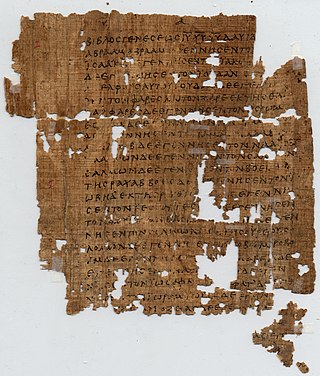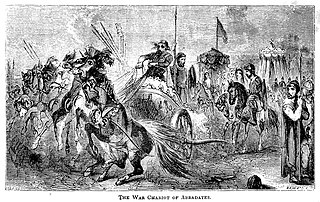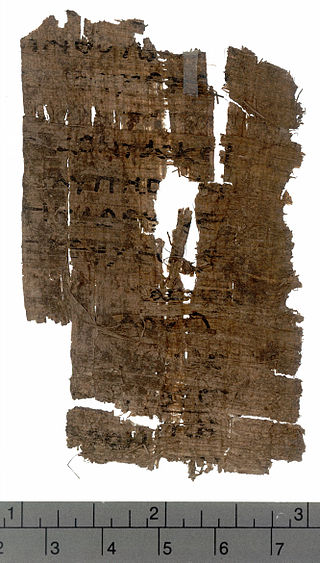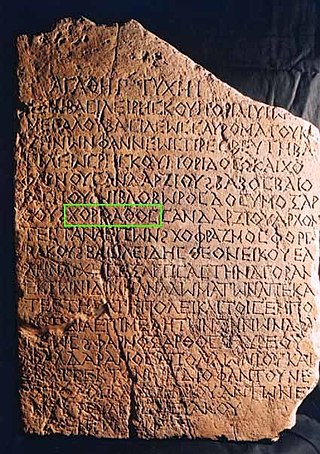Related Research Articles

The League of Corinth, also referred to as the Hellenic League, was a federation of Greek states created by Philip II in 338–337 BC. The League was created in order to unify Greek military forces under Macedonian leadership (hegemony) in their combined conquest of the Persian Achaemenid Empire.

Acharnae or Acharnai was a deme of ancient Athens. It was part of the phyle Oineis.
The Greek language underwent pronunciation changes during the Koine Greek period, from about 300 BC to 400 AD. At the beginning of the period, the pronunciation was close to Classical Greek, while at the end it was almost identical to Modern Greek.

Julia Drusilla was a daughter of Herod Agrippa, King of Judaea and Cypros and the sister of Berenice, Mariamne and Herod Agrippa II. Her son, Agrippa, was one of the few people known by name to have died in the eruption of Mount Vesuvius in 79 AD.

Papyrus 1 designated by "𝔓1", "ε 01 ", is an early Greek copy of a papyrus manuscript of one chapter of the Gospel of Matthew dating palaeographically to the early 3rd century. It was discovered in Oxyrhynchus, Egypt. It is currently housed at the University of Pennsylvania Museum.

Abradatas was a king, probably fictional, of Susa, known to us from Xenophon's partly fictional biography of Cyrus the Great, the Cyropaedia. According to it, he was an ally of the Assyrians against Cyrus the Great, while Cyrus was still a vassal to his uncle, Cyaxares II.

Papyrus 69 is a small fragment dating to the 3rd century. Scholars have debated whether its text is a witness to the Gospel of Marcion or the canonical Gospel of Luke.
Papyrus 19, signed by 𝔓19, is an early copy of the New Testament in Greek. The manuscript paleographically has been assigned to the 4th or 5th century.

Papyrus 49 (Gregory-Aland), designated by 𝔓49, is an early copy of the New Testament in Greek. It is a papyrus manuscript of the Epistle to the Ephesians, surviving in a fragmentary condition. The manuscript has been palaeographically assigned to the 3rd century. It was probably a part of the same manuscript as Papyrus 65. It came from Egypt and was purchased for the Yale University Library. Textually it is close to the Codex Sinaiticus and Codex Vaticanus. The text of the manuscript has been published several times.

The Tanais Tablets are two tablets from the city of Tanais near modern Rostov-on-Don, Russia. They are written in Greek and are dated to the late 2nd–3rd century AD. At the time, Tanais had a mixed Greek, Gothic and Sarmatian population. The tablets are public inscriptions which commemorate renovation works in the city. One of the tablets, Tanais Tablet A, is damaged and not fully reconstructed. The other, Tanais Tablet B, is fully preserved and is dated to 220 AD.

Papyrus 86, designated by siglum 𝔓86, is an early copy of the New Testament in Greek. It is a papyrus manuscript of the Gospel of Matthew. The manuscript palaeographically has been assigned to the 4th century.

Papyrus 100, designated by siglum 𝔓100, is an early copy of the New Testament in Greek. It is a papyrus manuscript of the Epistle of James. The surviving texts of James are verses 3:13-4:4; 4:9-5:1, they are in a fragmentary condition. The manuscript has been assigned paleographically to the late 3rd century, or early 4th century.
The Epistula ad Carpianum or Letter of Eusebius is the title traditionally given to a letter from Eusebius of Caesarea to a Christian named Carpianus. In this letter, Eusebius explains his ingenious system of gospel harmony, the Eusebian Canons (tables) that divide the four canonical gospels, and describes their purpose, ten in number.
Malamirovo or Hambarli Inscription is a Bulgarian Greek inscription of around 813 AD, commemorating Bulgarian victories of Krum over the Byzantines, now preserved in the Varna Archaeological Museum.
Codex Sinaiticus and Codex Vaticanus, two of the great uncial codices, representatives of the Alexandrian text-type, are considered excellent manuscript witnesses of the text of the New Testament. Most critical editions of the Greek New Testament give precedence to these two chief uncial manuscripts, and the majority of translations are based on their text. Nevertheless, there are many differences between these two manuscripts. A recent scientific comparative study of interest published on these two Alexandrian codices is "The Relationship between Vaticanus & Sinaiticus and the Majority Text in Galatians" by Dr. Graham G. Thomason and "THE SIGNIFICANCE OF SPLIT TEXT-TYPES FOR THE RECOVERY OF THE ORIGINAL TEXT OF THE GREEK NEW TESTAMENT" by Dr LESLIE McFALL - both are freely made available on the internet. Historically, the true character of these two Alexandrian manuscripts was quickly and thoroughly challenged by Dean John William Burgon's exhaustive analysis: "It is in fact easier to find two consecutive verses in which these two MSS differ the one from the other, than two consecutive verses in which they entirely agree."

The Iron Age Greek migrations were effected by a population of émigrés from amidst the displacements and reconstruction that occurred in Greece proper from the middle of the 11th century to the end of the 9th century BCE. The movements resulted in the settlement of the Aegean islands, Cyprus, Crete and the western coast of Asia Minor and the founding of new cities, which afterwards became centers of the Greek civilization. The migrations by various tribal groups were effected in consecutive waves known as the Aeolic, Ionian, Doric and Achaean (Arcadian) migrations. The movements differed from the Greek colonisation of the Archaic period in that they were more ad hoc affairs, rather than being the result of a planned process of colonisation on the part of the mother city. They are also less well-documented historically and in folk histories are often said to have been led by a mythologized or semi-legendary leader, such as Hercules or Orestes.
Descriptions in antiquity of the execution cross, whether by Christians or non-Christians, present the instrument ordinarily used in putting people to death by crucifixion as composed of two wooden pieces. Whether the two pieces of timber of the normal execution cross were permanently conjoined or were merely put together for the purpose of the execution is not stated.
Textual variants in the Gospel of Luke are the subject of the study called textual criticism of the New Testament. Textual variants in manuscripts arise when a copyist makes deliberate or inadvertent alterations to a text that is being reproduced. An abbreviated list of textual variants in this particular book is given in this article below.
Conditional clauses in Ancient Greek are clauses which start with εἰ (ei) "if" or ἐάν (eān) "if ". ἐάν (eān) can be contracted to ἤν (ḗn) or ἄν (ā́n), with a long vowel. The "if"-clause of a conditional sentence is called the protasis, and the consequent or main clause is called the apodosis.
Papyrus 141 is what remains of an early copy of the New Testament in Greek. It is a papyrus manuscript of Luke. The text survives on two disparate fragments of the same codex, one from chapter 2 and one from chapter 24. The manuscript has been assigned paleographically to the 3rd century.
References
- ↑ Source: http://www.attalus.org/docs/other/inscr_24.html
- ↑ Regions (IG VII-IX) Delphi SGDI II 1708, Phokis — Delphi — 170-157/56 BC
- ↑ Scott, M., 2014,Delphi: A History of the Center of the Ancient World, Oxford